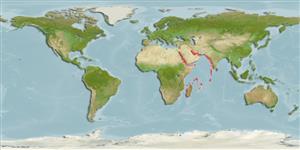Common names from other countries
Environment: milieu / climate zone / depth range / distribution range
Écologie
; profondeur 0 - 65 m (Ref. 106819). Tropical
Distribution
Pays | Zones FAO | Écosystèmes | Occurrences | Introductions
Western Indian Ocean: From Pakistan westwards to the Arabian Gulf extending to the east African coast to South Africa and to Madagascar and Mauritius. Introduced in the Mediterranean through the Suez Canal and established up to the northern Tyrrhenian Sea.
Length at first maturity / Taille / Poids / Âge
Maturity: Lm 7.4 range ? - ? cm Max length : 16.2 cm CW mâle / non sexé; (Ref. 115276); 16.2 cm CW (female)
Lives mainly in coastal waters in seagrass meadows and along mangroves (Ref. 115276), and intertidal mudflats (Ref. 128960). Found under rocks and in rock pools, on sandy or muddy substrate (Ref. 111207). Larger biomass is seen between depths of 2 to 15 m. Small juveniles are found in very shallow waters (less than 1 m); females occupy deep-water zones during spawning (Ref. 115276). Opportunistic predator, primarily a carnivore preying on a variety of benthic animals and less marine plants and seagrass (Ref. 108412). Prolific predators of bivalves. Some suggested that they're opportunistic omnivores or detritivores, feeding on carrion, especially on fishing-discards. Efficient night time forager, using a characteristic zigzag search pattern to locate prey (Ref. 115276).
Safaie, M., J. Pazooki, B. Kiabi and M.R. Shokri. 2013. (Ref. 107016)
Statut dans la liste rouge de l'IUCN (Ref. 130435)
statut CITES (Ref. 108899)
Not Evaluated
Not Evaluated
Menace pour l'homme
Harmless
Utilisations par l'homme
| FishSource |
Outils
Sources Internet
Estimates based on models
Résilience
Haut, temps minimum de doublement de population inférieur à 15 mois (K=1.6-1.7).
